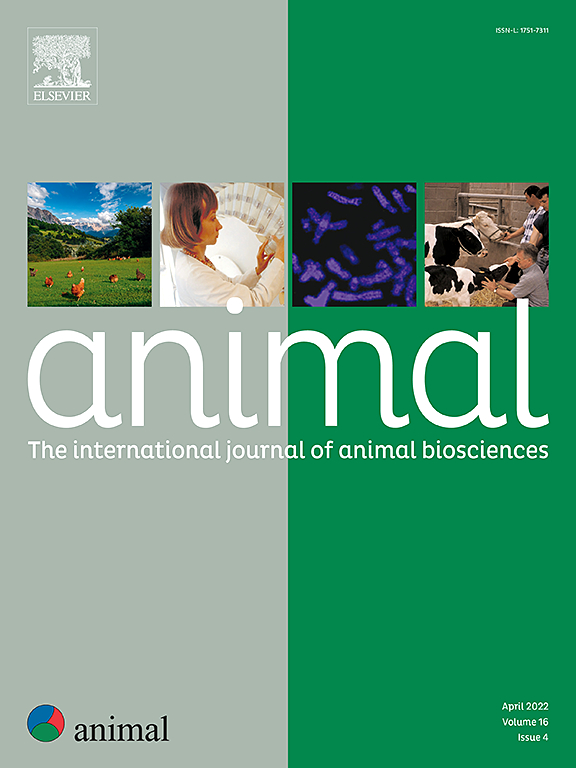Variability of daily feed intake as an indicator of resilience in Pietrain pigs
IF 4
2区 农林科学
Q1 AGRICULTURE, DAIRY & ANIMAL SCIENCE
引用次数: 0
Abstract
There is a growing need to produce more resilient livestock that can cope with extreme environments and their associated impacts. Daily feed intake (DFI) is a promising metric for the development of resilience indicators (RIs), as reduced feed consumption is widely recognised as a clinical sign of disease. However, there is no consensus on which DFI-based RIs are the most informative. The objectives of this study were: (i) to evaluate the most common DFI-based RIs and their relationships with feed efficiency traits (FETs), (ii) to investigate the relationship between these indicators and progeny mortality rates on commercial farms, and (iii) to gain insight into their biological mechanisms. A total of 111 121 DFI records of 1 634 healthy purebred Pietrain boars were used, ranging from 47 to 90 days, with an average of 69 DFI records per boar. Three RIs were calculated: residual variance, RMSE and logarithm of the variance of the deviations from an expected pattern (LnVar). A classical animal model was used to estimate the variance components of each RI, and a bivariate model was implemented to estimate the genetic correlation between RIs and the FET. Furthermore, a preliminary mortality study was carried out using data from 6 889 progeny of 55 boars on farms catalogued as virulent for porcine reproductive and respiratory syndrome. Progeny mortality was calculated for each contemporary group (farm and batch) of the offspring, and sires were classified into three levels of resilience. A Bayesian linear model was used to determine whether the differences in progeny mortality rate between the levels of resilience were relevant. On the other hand, a weighted single-step genome-wide association study was performed for each RI and the FET, using a total of 1 216 genotypes. RIs showed moderate heritability ( = 0.27–0.49) and moderate to strong genetic correlation with FET. Progeny of resilient sires had an 80% probability of at least a 2.5% higher survival rate. Overlapping genomic regions were found for RIs and feed conversion ratio, highlighting DOCK1, SYK and SPTLC1 genes for their potential roles in modulating immune responses and/or metabolism. The LnVar of deviations from the population mean was the most promising indicators (LnVar-Pop) for disease resilience, as it was the RI that better captured differences in progeny mortality. Furthermore, these results suggest a common biological basis for RIs and FET of interest to breeding programmes. Further studies are needed to validate them.
作为皮特兰猪抗逆性指标的日采食量变化。
越来越需要生产更有弹性的牲畜,以应对极端环境及其相关影响。日采食量(DFI)是弹性指标(RIs)发展的一个有希望的指标,因为饲料消耗减少被广泛认为是疾病的临床征兆。然而,对于哪种基于dfi的RIs信息最丰富,目前还没有达成共识。本研究的目的是:(i)评估最常见的基于dfi的RIs及其与饲料效率性状(fet)的关系,(ii)调查这些指标与商业养殖场子代死亡率之间的关系,以及(iii)深入了解其生物学机制。试验共使用1 634头健康的Pietrain纯种公猪111 121条DFI记录,时间为47 ~ 90日龄,平均每头公猪69条DFI记录。计算三个RIs:残差方差、RMSE和偏离预期模式方差的对数(LnVar)。采用经典动物模型估计各RI的方差成分,并采用双变量模型估计RIs与FET之间的遗传相关性。此外,对55头猪的6889个子代进行了初步的死亡率研究,这些子代猪被归类为猪繁殖和呼吸综合征毒性猪。计算后代的每个当代群体(农场和批次)的后代死亡率,并将后代分为三个恢复力水平。采用贝叶斯线性模型来确定不同恢复力水平之间后代死亡率的差异是否相关。另一方面,对每个RI和FET进行加权单步全基因组关联研究,共使用1216个基因型。RIs具有中等遗传力(h2 = 0.27-0.49),与FET具有中至强遗传相关性。弹性种群的后代有80%的可能性至少高出2.5%的存活率。RIs和饲料转化率的基因组区域重叠,突出了DOCK1、SYK和SPTLC1基因在调节免疫反应和/或代谢中的潜在作用。与种群均值偏差的LnVar是最有希望的疾病恢复力指标(LnVar- pop),因为它是RI,可以更好地捕捉后代死亡率的差异。此外,这些结果表明,RIs和FET具有共同的生物学基础,对育种计划有重要意义。需要进一步的研究来验证它们。
本文章由计算机程序翻译,如有差异,请以英文原文为准。
求助全文
约1分钟内获得全文
求助全文
来源期刊

Animal
农林科学-奶制品与动物科学
CiteScore
7.50
自引率
2.80%
发文量
246
审稿时长
3 months
期刊介绍:
Editorial board
animal attracts the best research in animal biology and animal systems from across the spectrum of the agricultural, biomedical, and environmental sciences. It is the central element in an exciting collaboration between the British Society of Animal Science (BSAS), Institut National de la Recherche Agronomique (INRA) and the European Federation of Animal Science (EAAP) and represents a merging of three scientific journals: Animal Science; Animal Research; Reproduction, Nutrition, Development. animal publishes original cutting-edge research, ''hot'' topics and horizon-scanning reviews on animal-related aspects of the life sciences at the molecular, cellular, organ, whole animal and production system levels. The main subject areas include: breeding and genetics; nutrition; physiology and functional biology of systems; behaviour, health and welfare; farming systems, environmental impact and climate change; product quality, human health and well-being. Animal models and papers dealing with the integration of research between these topics and their impact on the environment and people are particularly welcome.
 求助内容:
求助内容: 应助结果提醒方式:
应助结果提醒方式:


